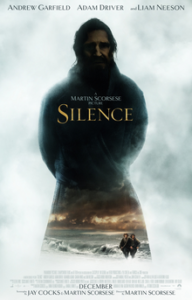 There are many wonderful reviews and critiques out there for Martin Scorsese’s latest film (and I would dare say, masterpiece) Silence. What I want to dive into is the faith journey of the most central character, Father Sebastião Rodrigues, and what we can learn from his story arc. (Beware, this is a spoiler-laden exploration intended only for those who have seen the film).
There are many wonderful reviews and critiques out there for Martin Scorsese’s latest film (and I would dare say, masterpiece) Silence. What I want to dive into is the faith journey of the most central character, Father Sebastião Rodrigues, and what we can learn from his story arc. (Beware, this is a spoiler-laden exploration intended only for those who have seen the film).
Father Rodrigues is the most optimistic and forward thinking of the padres we meet in the film. When his companion Francisco Garrpe is grumbling about their daily struggle, or losing patience with the Japanese customs, Rodrigues is always seeing the brighter side and finding solutions. His faith is incredibly strong, but so is his sin… pride. His pride causes him to judge the actions of others harshly, and it also often blinds him to reality.
Rodrigues also grapples with the turmoil and persecution of the Japanese people. He asks God many times why these “poor people” have to suffer so much. He sees them as beasts of burden, referring to them as miserable. He even calls one a “poor wretch.” Though this sounds denigrating at a glance, that is not Rodrigues’ heart. He definitely has the intention of compassion, but he lacks the understanding to see that the standard for all Christians is the same whether priest or peasant.
This is made very plain when some of the villagers are told by government officials and inquisitors that they must trample the fumie (images of Christianity) as a public renunciation of faith in order to save their lives. Rodrigues tells them that is okay, implying that they will still believe even if they trample the fumie. However, it is made plain that he would not excuse himself in the same manner if it came down to it because he holds his own actions at a higher standard. Rodrigues’ self-pride is the thorn in his flesh keeping him from true understanding and abundant ministry.
Like most significant events in the Bible, we see the number three. The breaking of Rodrigues comes in three parts, similarly to the breaking of Peter when he denied Christ three times. Rodrigues’ pride is first challenged by the death of Mokichi, one of the most loyal and fervent members of the Japanese faith. He and two other villagers are sentenced to die by crucifixion on crosses basically in the shorebed. It takes Mokichi four miserable days to die, and yet he faces his death with bravery, singing a hymn with his last breath.
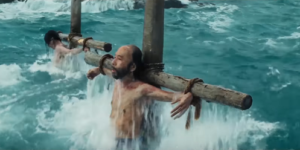 The ocean is a significant symbolism in both the film and the book as representing the presence of God. This is especially remarkable when you consider Japan is an island surrounded by it. Likewise, water is the general symbol of God’s power and cleansing throughout the Scriptures. Mokichi is ravaged by waves for much of the four days he hangs on his cross. When he is finally brought down to be burned on a funeral pyre, his body is so full of water that it smokes before it catches flame. This is incredibly powerful image, but also reminds us how God speaks in signs and wonders. Mokichi was filled with God’s glory, and God’s glory had the final say as he passed away from this earth.
The ocean is a significant symbolism in both the film and the book as representing the presence of God. This is especially remarkable when you consider Japan is an island surrounded by it. Likewise, water is the general symbol of God’s power and cleansing throughout the Scriptures. Mokichi is ravaged by waves for much of the four days he hangs on his cross. When he is finally brought down to be burned on a funeral pyre, his body is so full of water that it smokes before it catches flame. This is incredibly powerful image, but also reminds us how God speaks in signs and wonders. Mokichi was filled with God’s glory, and God’s glory had the final say as he passed away from this earth.
Rodrigues and Garrpe are separated soon after Mokichi’s death and Rodrigues ends up in the hands of the inquisitor. The inquisitor keeps him quite comfortably in prison, as means of revealing to the young padre how much easier his life could be if he would recant his faith.
Rodrigues remains strong to the point of bullheaded throughout his imprisonment, but his pride is confronted a second time when he is brought to a beach again, this time by the inquisitor, to witness Father Garrpe and some of his flock be executed. They are wrapped in straw mats and tossed into the sea. To worsen the matter, the inquisitor’s men falsely informed Garrpe that Rodrigues had apostatized, hoping it would sway him to do the same. It is beautifully ironic that Garrpe, the one who initially struggled the most when they reached Japan, showed perhaps greater faith in the end. He dies in submerged with the brothers and sisters he spiritually led. Again, the ocean is present in reminding us that God is ever with His faithful.
Even as he watches from afar, Rodrigues begs Garrpe to apostatize and live, yet he still remains unwilling to do that himself.
The third test arrives when he is finally face-to-face with Father Ferreira, the man he and Garrpe came to Japan to find in the first place. Here reality grounds him as he discovers Ferreira’s apostatization was not just a rumor or slander. He lives a Japanese life under Japanese law and custom. He has forsaken his faith (at least on the surface), and even goes so far as to claim Christianity can never take root in Japan. He is no longer is the padre and spiritual leader Rodrigues held in high esteem. As he listens to Ferreira’s tale, he declares with tears in his eyes, “You are a disgrace.”
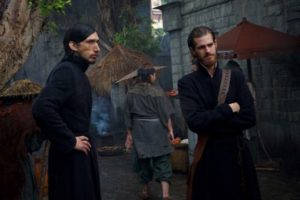 A group of Japanese Christians currently in prison with Rodrigues are sentenced to “the pit,” which is basically days of being hung upside down with your head underground while blood slowly drips out of an incision in your neck. Father Ferreira himself underwent this torture, and describes the effects in great detail. Rodrigues is then given the ultimatum of trampling the fumie and saving them all, or dying in the pit along with the other Christians. Rodrigues falls apart as he clings futilely to his pride, while calling it faith. Ferreira points out to him very passionately that he is not Jesus. Only Christ can be Christ.
A group of Japanese Christians currently in prison with Rodrigues are sentenced to “the pit,” which is basically days of being hung upside down with your head underground while blood slowly drips out of an incision in your neck. Father Ferreira himself underwent this torture, and describes the effects in great detail. Rodrigues is then given the ultimatum of trampling the fumie and saving them all, or dying in the pit along with the other Christians. Rodrigues falls apart as he clings futilely to his pride, while calling it faith. Ferreira points out to him very passionately that he is not Jesus. Only Christ can be Christ.
And then, much like Elijah (1 Kings 19:11-13), Rodrigues finally hears God break the silence to him in a quiet, gentle voice…
This is my favorite moment in the film, because it is a moment so many of us can connect with. I’m going to go out on a limb here and say we all have a voice for God in our heads when we hear Him speak to us. He speaks to us personally and tenderly. Christ speaks to Rodrigues’ heart and assures him it’s okay to trample His image, because He died to free us all from the bonds of this world and break the yokes of such burdens. This is a remarkable image of God’s Grace, a gentle voice reminding us that it is not our works that keep us pure, but His steadfast love working in a repentant heart and contrite spirit. We are imitators of Christ, but only He is Savior.
Like Rodrigues, it is difficult for many of us to accept this truth sometimes. We feel what we do or do not do is what keeps us Holy, but we cannot perpetuate holiness of our own volition. Fortunately for humanity, God always reaches us where we are because He loves His children.
Once Rodrigues steps on the fumie, he knows he will be defamed in his home country and will always have to wear the cloak of being a priest who apostatized. This sounds terrible on the surface, but ultimately this death to self and pride will be what sets him free in Christ.
Years later, when Kichijiro, a Judas of a character who has been a thorn in his side, begs him to hear his confession, Rodrigues finally grasps the truth that had eluded him in his prideful youth. Only in brokenness is he finally truly able to imitate Christ’s love and grace. As he hears Kichijiro’s confession, he prays and realizes God was never silent at all. The silence was God’s dwelling place. It was in the silence that he heard His voice.
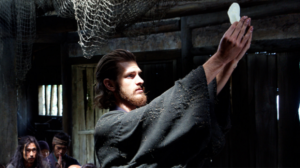 The silence in Silence is not only demonstrated in the way the padres feel about God seeming distant during the turmoil of Japanese ministry, but it is also a way they are free to worship Him. In the silence of their spirits, they can have conversations with God that no one else can hear. The silence is a realm where no persecution can reach. I believe in the moment that Ferreira is speaking to Rodrigues and lets the phrase “our God” slip, it is a reveal that Ferreira never apostatized in his heart. Perhaps he simply understood the beauty of seeking God in the silence.
The silence in Silence is not only demonstrated in the way the padres feel about God seeming distant during the turmoil of Japanese ministry, but it is also a way they are free to worship Him. In the silence of their spirits, they can have conversations with God that no one else can hear. The silence is a realm where no persecution can reach. I believe in the moment that Ferreira is speaking to Rodrigues and lets the phrase “our God” slip, it is a reveal that Ferreira never apostatized in his heart. Perhaps he simply understood the beauty of seeking God in the silence.
There’s a lot of poetry in Rodrigues having the same fate as Ferreira. When Rodrigues dies an old man, the Japanese governing officials do whatever they can to keep him from having a Christian burial, but his wife sneaks a crucifix into his hand before he reaches the pyre. As we see the holy symbol in his grasp as the final image of the film, we see the visual representation of the silence. It may not be visible to others, but it is always there.

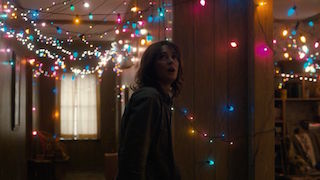

1 comment